Palo Verde Trees: Blue Palo Verde and Foothills Palo Verde (Pictures and Identification)

Palo verde is a group of small trees or large spiny shrubs with green branches, yellow pea-like flowers, brown seed pods, and small leaves that appear for a short time after rainfall. The deciduous palo verde is a desert tree native to the hot, arid regions of California, Arizona, and Mexico. The multi-stemmed ornamental tree thrives during drought and is an excellent landscape tree for filtered shade during scorching weather.
Several species of palo verde trees are native to North America. The most common palo verde trees are the foothill palo verde which is also called Mexican palo verde (Parkinsonia aculeata), blue palo verde (Parkinsonia florida), and desert museum palo verde (Parkinsonia x ‘Desert Museum’).
This article is a guide to one of the most drought-tolerant trees — the palo verde. Descriptions and pictures of this ornamental desert tree will help identify the various species. You will also find helpful tips on choosing a suitable species for your front or backyard.
Palo Verde Trees
Palo verde (botanical name: Parkinsonia) is a small group of flowering trees that grow in hot climates. The large palo verde shrubs or small trees grow between 16 and 40 ft. (5 – 12 m) high. The heat-tolerant trees are classified as a “dry season deciduous tree,” meaning their leaves drop when the ground is parched.
Palo verde trees are a member of the pea family Fabaceae. Like all legumes, this thorny tree produces fruit in the form of brown, leathery seed pods. A characteristic of this beautiful tree is its thorny branches.
Palo verde trees are suitable for growing outdoors in USDA zones 8 through 11. The palo verde tree has been the official state tree of Arizona since 1954.
Generally, palo verde trees are identified in the desert landscape by their yellowish-green colors. Some species of palo verde trees are covered in small golden yellow flowers when in bloom in spring or fall. Other species have yellowish-green leaves. Also, when the tree has no flowers or leaves, its characteristic green bark creates visual appeal.
Palo verde—also written as paloverde—literally means green stick in Spanish. This name refers to the distinctive green trunk and branches that help identify the tree. Other common names of palo verde trees are Jerusalem thorn, jelly bean tree, yellow palo verde, and foothill palo verde.
The palo verde has a unique and amazing growth habit. Once established in the desert landscape, a palo verde survives without additional water. The small pinnate leaves help reduce moisture loss, and the green bark can photosynthesize. Additionally, during extreme drought, the leaves shed, and the branches die back. However, after water becomes available, the tree will revive and start growing again.
Foothill or Yellow Palo Verde (Parkinsonia aculeata)
Also called the Mexican palo verde, the attractive yellow palo verde is identified as an upright branching tree with yellowish-green leaves and pale-yellow spring-blooming flowers. Sometimes soft seed-filled pods appear on the tree. Like all palo verde trees, the foothill palo verde tree has characteristic green bark. This shrub-like tree grows around 16 ft. (5 m) tall.
Blue Palo Verde Tree (Parkinsonia florida)
The stunning blue palo verde tree is a fast-growing multi-stemmed tree with gray-green leaves, small bright yellow flowers, and large, hard seed pods. This ornamental tree has bluish branches and twigs, which perform photosynthesis. Compared to the foothill tree, the blue palo verde is larger, growing 33 – 40 ft. (10 – 12 m) high.
Desert Museum Palo Verde (Parkinsonia x ‘Desert Museum’)
The eye-catching desert museum palo verde tree has identifiable showy brightly colored yellow, long-blooming flowers. The lemon-yellow trumpet-shaped flowers have five feathery petals. This medium-sized tree has an upright spreading rounded canopy with bright green foliage. The hybrid palo verde tree is a thornless tree growing 25 ft. (7.6 m) tall and wide.
Palo Verde Tree Leaves
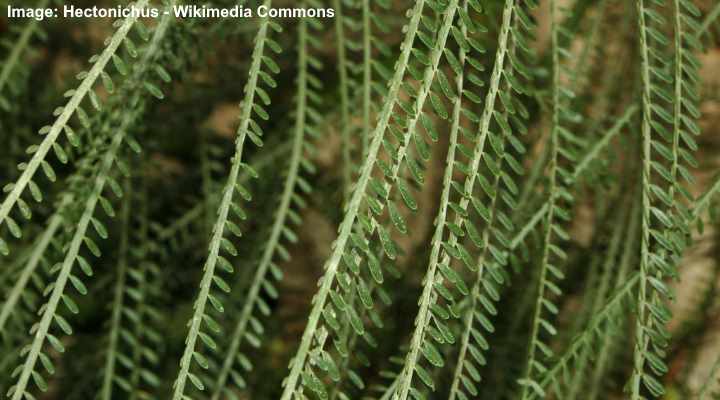
Palo verde (Parkinsonia aculeata) leaves
Palo verde leaves are identified as pinnate leaves consisting of several small oval or linear leaflets. The small green or bluish-green leaves grow on thorny branchlets that measure 6” to 9” (15 – 23 cm) long. The small palo verde leaves help prevent moisture loss from the plant during droughts.
During extreme drought, it’s not uncommon for the shrub-like tree to shed all its leaves until it gets enough moisture again. Due to the sparse leaf growth and the green, arching branches, the wide-spreading canopy only provides dappled shade.
Palo Verde Tree Bark

Palo verde (Parkinsonia florida) bark
Bark on palo verde trees is the most distinctive identifying trait of this desert tree. The bark covering the palo verde trunk, branches, and limbs is a unique green color. This characteristic allows the plant to photosynthesize even when there are no leaves. In addition, the green bark is smooth with horizontal grayish lenticels.
Looking at pictures of palo verde trees, it’s easy to see why the tree is called green pole or green stick in Spanish. The green bark color comes from high levels of chlorophyll that help the plant produce energy during harsh, scorching weather.
Most species of palo verde trees have sharp spines or thorns growing on the branches. The exception to this is the desert museum palo verde hybrid, which is a thornless tree.

Palo verde (Parkinsonia aculeata) thorns
Palo Verde Tree Flowers
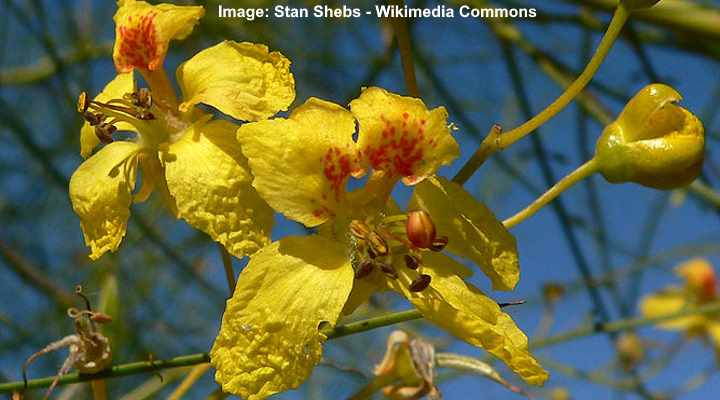
Palo verde (Parkinsonia aculeata) flowers
Flowers on a palo verde tree are stunning bright-yellow showy blooms with five papery petals, orange speckles and distinctive orange or red stamens. When the ornamental trees are in bloom, the sparse crown transforms into bright yellow soft puffs. The large yellow flowers bloom in late spring and sometimes again in late fall.
Palo Verde Fruit
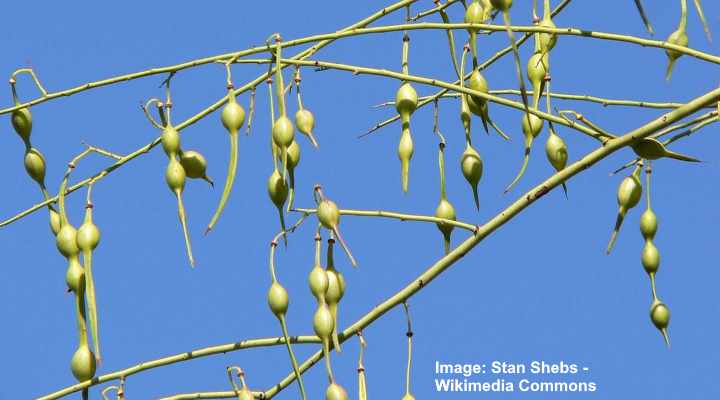
Palo verde (Parkinsonia aculeata) seed pods
Fruit from the palo verde tree is clusters of leathery seedpods, each containing two or more seeds. The light brown, red, or green pods contain large black or brown edible seeds with a sweet-pea taste. The easily identifiable pods look like beaded chains dangling from bare branches.
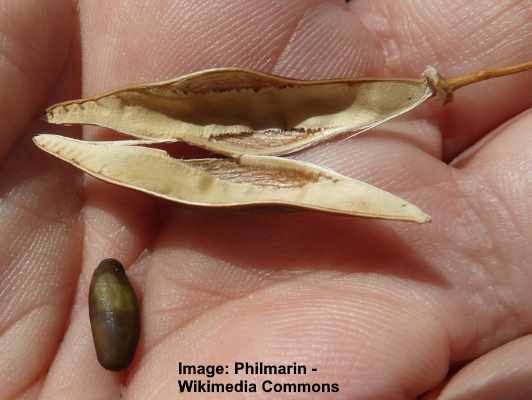
Palo verde (Parkinsonia aculeata) seed
It is easy to propagate palo verde plants using seeds from the tree. All you need to grow a new tree is to harvest the seeds that fall and allow them to dry. Then plant them in moist potting soil. It takes about two weeks for germination.
How to Identify Palo Verde Trees
Palo verde trees are easy to identify due to their green bark, large, showy yellow flowers, dangling seed pods, and thorny branches. The ornamental trees have a characteristic upward branching habit and long, pinnate leaves with tiny leaflets growing oppositely. The small, multi-stemmed green trees grow up to 40 ft. (12 m) tall.
Types of Palo Verde (with Pictures) – Identification
Let’s look in more detail at the three most common types of palo verde trees—the yellow palo verde, blue palo verde, and desert museum palo verde. Although all palo verde trees have similar characteristics—green bark, yellow flowers, and pinnate leaves, individual species have subtle differences that help identify them.
Foothills Palo Verde (Parkinsonia aculeata)
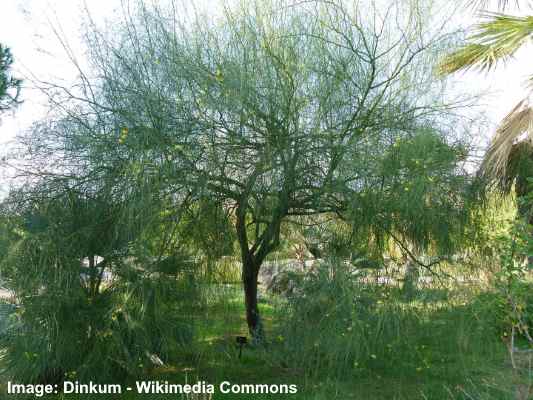
Foothills palo verde (Parkinsonia aculeata) tree
Also called the yellow palo verde, Mexican palo verde, Jerusalem thorn or little-leaved palo verde, this desert tree has small yellowish-green leaves, pale yellow flowers, and long soft seedpods. One of the smallest palo verde trees, the foothills tree only grows 16 ft. (5 m) tall and looks more like a shrub.
The deciduous foothills palo verde is a perennial deciduous tree that sheds its leaves in the dry season. This shrub-like landscape tree has a slower growth rate than the other species in the genus Parkinsonia. In addition, the tree’s flowers are paler, and the tree doesn’t grow as tall as the blue palo verde or desert museum palo verde.
As with all ornamental palo verde trees, showy yellow funnel-shaped or open petalled flowers brighten up the desert landscape in spring.
Foothill palo verde trees have many uses as shade trees, specimen trees, or small ornamental trees in a residential landscape. Because of its high tolerance for drought, this palo verde species is ideal for planting in a xeriscape landscaping or gardens where watering plants is challenging. Planting the tree in sandy, well-drained soil will ensure the beautiful tree grows for many years.
Palo Verde Leaves: Foothills palo verde tree leaves are typically green and pinnately compound. The long spiny stems have small oval leaves growing sparsely in pairs. The leafy branches measure 6” to 8” (15 – 24 cm) long.
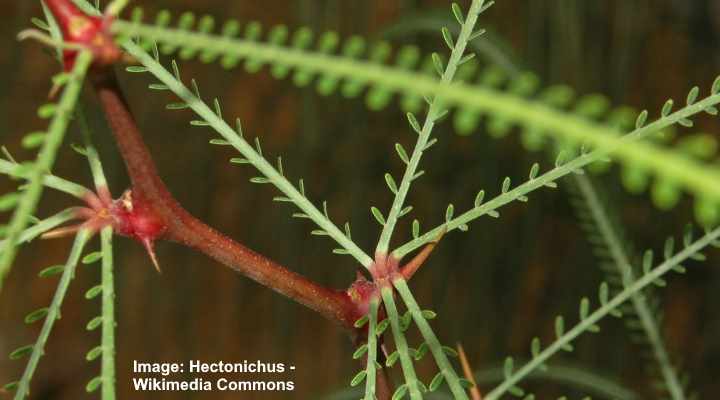
Parkinsonia aculeata leaves and thorns
Palo Verde Bark: Foothills palo verde tree bark is light green and smooth with horizontal lenticels and light-colored lines running vertically. The chlorophyll-rich bark allows the tree to continue growing when it sheds its leaves.

Parkinsonia aculeata bark
Palo Verde Flowers: Foothills palo verde flowers are showy yellow or pale yellow trumpet-shaped blossoms measuring 1” (2.5 cm) across. In addition, orange stamens help to identify these palo verde flowers.
Palo Verde Identification
To identify a foothills palo verde tree, look for its dark green to pale green bark and yellowish-green small oval leaves, creating a rounded, open crown with a spreading habit.
Blue Palo Verde (Parkinsonia florida)
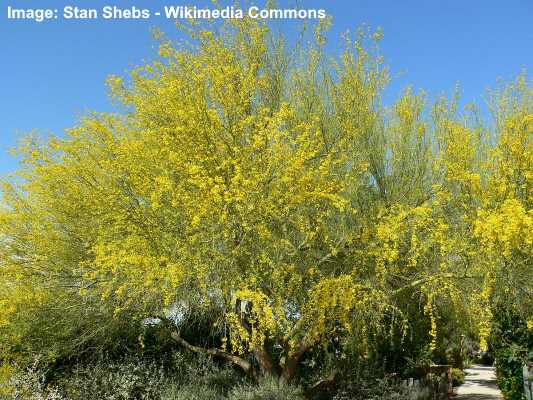
Blue palo verde (Parkinsonia florida) tree in bloom
The blue palo verde tree grows as a small tree or large shrub and has bluish-green leaves, bright yellow showy flowers, and hard seedpods. The blue palo verde is the taller of the native Parkinsonia trees and grows between 33 and 40 ft. (10 – 12 m).
The blue palo verde desert tree is identified in the landscape by its loose spreading crown. The silvery-green foliage typically only appears after rainfall. At other times of the year, the visual appeal of the attractive tree is enhanced by the bluish-green bark.
An identifying feature of the blue palo verde tree is its flattened seed pods dangling on bare branches from fall through winter. Compared to the foothills palo verde, the pods are more prominent and flatter and may only contain two large brown seeds.
Blue palo verde trees are at their most spectacular in spring when they come into bloom. The dazzling yellow flowers can persist on the tree until midsummer, creating a magnificent floral display in a barren landscape. During this time, the brightly colored yellow blooms attract pollinators, making them useful landscaping trees.
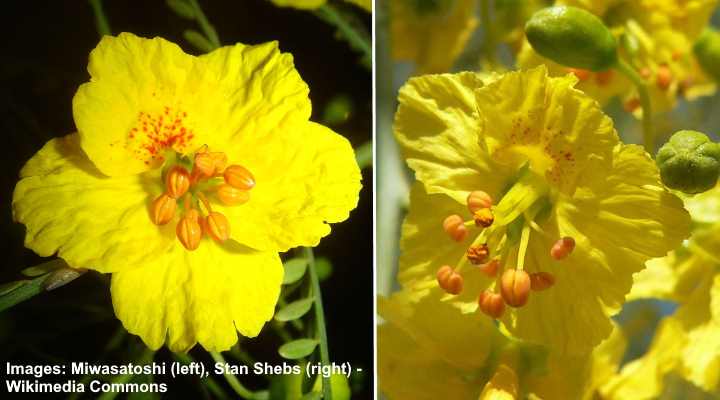
Blue palo verde (Parkinsonia florida) flower
This fast-growing shrub-like ornamental tree is exceptionally tolerant of drought, making it ideal for planting in arid gardens or xeric landscape sites. Even though tree foliage is sparse, it still makes a good tree for light shade. Its greenish-blue silhouette is also attractive.
Palo Verde Leaves: The blue palo verde tree has small oval to obovate leaves growing pinnately on compound leaves. The bluish-green foliage only appears on the thorny branches after rainfall. The small leaves grow on short stems.
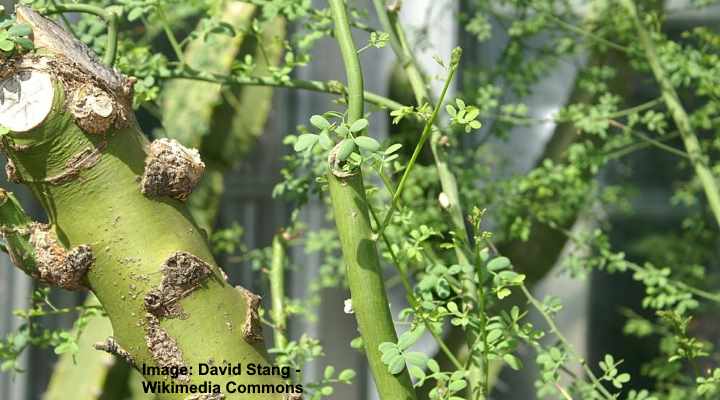
Blue palo verde (Parkinsonia florida) leaves and bark
Palo Verde Bark: The blue palo verde tree has bluish-green, thin bark with a smooth texture. As the tree ages, noticeable grayish lenticels appear around the trunk, giving it a cracked appearance.
Palo Verde Flowers: The blue palo verde tree flowers are bright yellow and grow in clusters of four to five flowers. The golden-yellow flowers with light splashes of orange measure 2” to 4” (5 – 10 cm) across and cover the tree when in bloom.
Palo Verde Identification
To identify a blue palo verde tree, look for its brightly colored spring flowers, bluish-green bark, and upward spreading crown. The pea-like flowers, with their papery yellow petals, have distinctive orange markings and vibrant reddish stamens. The yellow flowers contrast with the light green branches.
Desert Museum Palo Verde (Parkinsonia x ‘Desert Museum’)
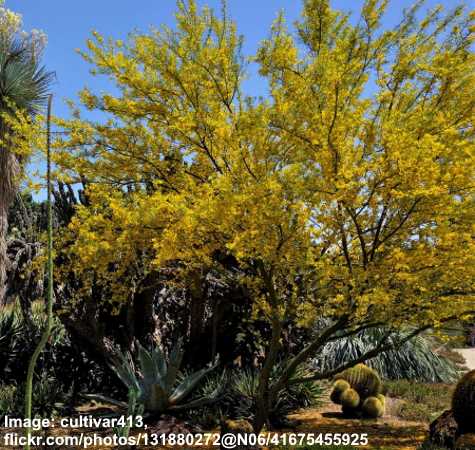
Desert Museum Palo Verde (Parkinsonia x ‘Desert Museum’)
The desert museum palo verde is an attractive tree with light green stems, bright yellow flowers, and tan-colored dangling seedpods. One of the identifying features of this palo verde species is its lack of thorns on green branches. The desert museum palo verde grows up to 30 ft. (10 m) tall and wide.
Desert museum palo verde tree flowers are brightly colored yellow flowers covering the tree from late spring through summer. The showy yellow flowers are similar to blue palo verde flowers—five yellow petals with orange speckles and orange stamens.

Parkinsonia x ‘Desert Museum’ flower
An interesting growth habit of the tree is that the flowers grow close to the green branches. This gives the green pole the appearance of a yellow flowering staff or wand. Also, when the wispy leaves appear after rainfall, the tiny leaves give the green tree a distinct feathery appearance.
The palo verde ‘Desert Museum’ is a thornless variety, making it appealing as a landscaping tree and light shade tree. The attractive upward spreading crown provides dappled shade without blocking light to understory flowering plants or shrubs.
This hybrid desert museum palo verde tree is a cross between Parkinsonia florida and Parkinsonia aculeata. Therefore the hybrid tree combines the best characteristics of both species trees. It is an attractive ornamental landscape tree with a strong branching habit and rapid growth. In addition, the tree produces abundant yellow flowers and few pods, meaning the tree isn’t messy.
Related articles:
